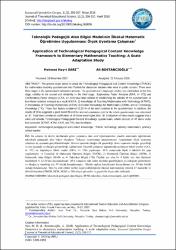| dc.contributor.author | SARI, Mehmet Hayri; BOSTANCIOĞLU, Ali | |
| dc.date.accessioned | 2019-03-25T11:16:42Z | |
| dc.date.available | 2019-03-25T11:16:42Z | |
| dc.date.issued | 09.03.2018 | |
| dc.identifier.uri | http://dergipark.gov.tr/download/article-file/438075 | |
| dc.identifier.uri | http://hdl.handle.net/11630/5585 | |
| dc.description | The present study aimed to adapt the Technological Pedagogical and Content Knowledge (TPACK) for mathematics teaching questionnaire into Turkish for classroom teachers who work in public schools. There were three stages in the questionnaire adaptation process. The questionnaire’s language validity was established in the first stage, validity in the second and reliability in the third stage. Exploratory Factor Analysis (EFA) and Confirmatory Factor Analysis (CFA) have been utilized in establishing the validity of the questionnaire. 372 classroom teachers’ responses have been used in EFA and 310 for CFA. A four-factor solution emerged as a result of EFA. These factors (in the order of factor loadings) were named as: 1) Knowledge of Teaching Mathematics with Technology (KTMT) under which items that belonged to Technological Pedagogical Knowledge (TPK), Technological Content Knowledge (TCK), and Technological Pedagogical Content Knowledge (TPCK) sub-sections merged together; 2) Knowledge of Teaching Mathematics (KTM) under which items that belonged to Pedagogical Content Knowledge (PCK) and Pedagogy Knowledge (PK) sub-sections merged together as one factor; 3) Content Knowledge for Mathematics (CKM) which included items from the Content Knowledge (CK) sub-section; and 4) Technology Knowledge (TK). Those four factors explained 62.20 % of the total variation in the questionnaire. In addition, the results of CFA suggested a good model fit; NNFI .98, NFI .97, CFI .98, IFI .98, RMR .06, and RMSEA .07. Cronbach’s Alpha (α) internal consistency and total item correlations were calculated to establish reliability. The internal consistency (α) for the whole questionnaire was calculated as .97. The α levels for each subscale was; .96 for TPACK, .94 for PCK, .89 for CK, and .91 for TK and total item correlation coefficients were higher than .30. Evaluation of these results suggests that a valid and reliable Technological Pedagogical Content Knowledge questionnaire, which consists of 47 items under four subscales (KTMT, KTM, CKM, and TK), was developed. | en_US |
| dc.description.abstract | The present study aimed to adapt the Technological Pedagogical and Content Knowledge (TPACK) for mathematics teaching questionnaire into Turkish for classroom teachers who work in public schools. There were three stages in the questionnaire adaptation process. The questionnaire’s language validity was established in the first stage, validity in the second and reliability in the third stage. Exploratory Factor Analysis (EFA) and Confirmatory Factor Analysis (CFA) have been utilized in establishing the validity of the questionnaire. 372 classroom teachers’ responses have been used in EFA and 310 for CFA. A four-factor solution emerged as a result of EFA. These factors (in the order of factor loadings) were named as: 1) Knowledge of Teaching Mathematics with Technology (KTMT) under which items that belonged to Technological Pedagogical Knowledge (TPK), Technological Content Knowledge (TCK), and Technological Pedagogical Content Knowledge (TPCK) sub-sections merged together; 2) Knowledge of Teaching Mathematics (KTM) under which items that belonged to Pedagogical Content Knowledge (PCK) and Pedagogy Knowledge (PK) sub-sections merged together as one factor; 3) Content Knowledge for Mathematics (CKM) which included items from the Content Knowledge (CK) sub-section; and 4) Technology Knowledge (TK). Those four factors explained 62.20 % of the total variation in the questionnaire. In addition, the results of CFA suggested a good model fit; NNFI .98, NFI .97, CFI .98, IFI .98, RMR .06, and RMSEA .07. Cronbach’s Alpha (α) internal consistency and total item correlations were calculated to establish reliability. The internal consistency (α) for the whole questionnaire was calculated as .97. The α levels for each subscale was; .96 for TPACK, .94 for PCK, .89 for CK, and .91 for TK and total item correlation coefficients were higher than .30. Evaluation of these results suggests that a valid and reliable Technological Pedagogical Content Knowledge questionnaire, which consists of 47 items under four subscales (KTMT, KTM, CKM, and TK), was developed. | en_US |
| dc.language.iso | eng | en_US |
| dc.identifier.doi | 10.30831/akukeg.368836 | en_US |
| dc.rights | info:eu-repo/semantics/openAccess | en_US |
| dc.subject | teknolojik pedagojik alan bilgisi, TPAB, teknoloji, ilkokul matematik, sınıf öğretmeni | en_US |
| dc.title | Teknolojik Pedagojik Alan Bilgisi (TPAB) Modelinin İlkokul Matematik (İM) Öğretimine Uygulanması: Ölçek Uyarlama Çalışması | en_US |
| dc.title.alternative | Application of Technological Pedagogical Content Knowledge Framework to Primary Mathematics Teaching: A Scale Adaptation Study | en_US |
| dc.type | article | en_US |
| dc.relation.journal | Kuramsal Eğitimbilim Dergisi | en_US |
| dc.department | Afyon Kocatepe Üniversitesi | en_US |
| dc.identifier.volume | 11 | en_US |
| dc.identifier.startpage | 296 | en_US |
| dc.identifier.endpage | 317 | en_US |
| dc.identifier.issue | 2 | en_US |
| dc.relation.publicationcategory | Makale - Ulusal Hakemli Dergi - Kurum Yayını | en_US |



















